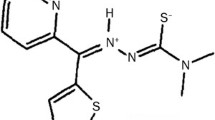Abstract
XK469 (NSC 656889) is a water-soluble member of the novel quinoxaline family of antitumor agents. In vitro, XK469 demonstrated selective cytotoxicity for several murine solid tumors including colorectal and mammary adenocarcinoma cell lines, when compared to both leukemia and normal epithelial cells. In vivo, XK469 was active against 7/7 murine tumors tested, including pancreatic ductal carcinomas #02 and #03, colon adenocarcinomas #38 and #51/A, mammary adenocarcinoma #16/C and the Adriamycin resistant mammary adenocarcinomas #16/C/ADR and #17/ADR. XK469 was efficacious both intravenously and orally. Regardless of dosing schedule, conventional mice tolerated higher total doses than SCID or nu/nu mice did. Despite these reduced doses, XK469 was active against xenografts of 4/6 human tumor lines including mammary adenocarcinoma MX-1, the small cell lung cancer DMS 273, the prostate model LNCaP and the CNS tumor SF295. The lower doses in the xenograft studies were below curative levels. The dose-limiting toxicity appeared to be myelosuppression with rapid host recovery (5–8 days), and in vitro assays of XK469 toxicity to murine bone marrow neutrophil progenitors CFU-GM (colony forming unit-granulocyte/macrophage) demonstrated concentration-dependent toxicity from 0.5–30 μg/mL. The difference in drug tolerance between BDF1 and SCID mice was detected in vitro as a 3-fold difference in the IC90 for CFU-GM, despite similar IC50 values. Comparative in vitro hematotoxicology studies revealed that human bone marrow CFU-GM tolerated XK469 as well as their SCID counterparts (IC90 values 5.7 vs. 7.4 μg/mL). Based on comparison with previously tested anti-cancer agents, these data suggest that humans will be able to tolerate XK469 doses that are efficacious against human tumor xenografts.
Similar content being viewed by others
References
LoRusso PM, Demchik L, Knight J, Polin L, Behrens CH, McRipley R, Gross JL, Harrison BA, Corbett TH: Preclinical antitumor activity of XK469. Proc AACR 35: 2390, 1994.
Fawzi, US Patent 4,609,396; Ura et al., US Patent 4,629,493; Serban et al., US Patent 4,803,273; Serban et al., US Patent 4,655,819; Serban et al., EP 0,023,785; Davis et al., 0,323,727 A2.
Corbett TH, Valeriote RA, Polin L, et al.Discovery of solid tumor active agents using a soft-agar-colony-formation-disk-diffusion-assay. In: Valeriote FA, Corbett TH, Baker LH (eds), Cytotoxic Anticancer Drugs: Models and Concepts for Drug Discovery and Development, Norwell, Massachusetts, Kluwer Academic Publishers, 1992, pp. 35-87.
LoRusso PM, Polin L, Biernat LA, Valeriote FA, Corbett TH: Activity of datelliptium acetate (NSC311152; SR95156A) against solid tumors of mice. Invest New Drugs 8:253-261, 1990.
Corbett TH, Valeriote FA. Rodent models in experimental chemotherapy. In: Kallman RF (ed), The Use of Rodent Tumors in Experimental Cancer Therapy: Conclusions and Recommendations, Elmsford, NY, Pergamon Press, 1987, pp 233-247.
Corbett TH, Griswold DP Jr., Roberts BJ, Peckham JC, Schabel FM Jr: Tumor induction relationships in development of transplantable cancers of the colon in mice for chemotherapy assays, with a note on carcinogen structure. Cancer Res 35: 2434-2439, 1975.
Corbett RH, Leopold WR, Dykes DJ, Roberts BJ, Griswold DP Jr., Schabel FM Jr. Toxicity and anticancer activity of a new triazine antifolate (NSC 127755). Cancer Res. 42: 1701- 1715, 1982.
Corbett TH, Griswold DP Jr., Roberts BJ, Peckham JC, Schabel FM Jr. Evaluation of single agents and combinations of chemotherapeutic agents in mouse colon carcinomas. Cancer 2660-2680, 1977.
Corbett TH, Roberts BJ, Trader MW Jr., Laster WR Jr., Griswold DP Jr., Schabel FM Jr. Response of transplantable tumors of mice to anthracenedione derivatives alone and in combination with clinically useful agents. Cancer Treat Rep 66(5): 1187-1200, 1982.
Corbett TH, Roberts JB, Leopold WR, Peckham JC, Wilkoff LJ, Griswold DP Jr., Schabel FM Jr. Induction and chemotherapeutic response of two transplantable ductal adenocarcinomas of pancreas in C57Bl/6 mice. Cancer Res 44: 717- 726, 1984.
Corbett TH, Griswold DP, Roberts BJ, Peckham JC, Schabel Jr. FM. Biology and therapeutic response of a mouse mammary adenocarcinoma (16/C) and its potential as a model for surgical adjuvant chemotherapy. Cancer Treat Rep, 62: 1471-1488, 1978.
Parchment RE, Huang M., Erickson-Miller CL: Roles for in vitro myelotoxicity tests in preclinical drug development and clinical trial planning. Toxicol Pathol 21: 241-250, 1993.
Parchment RE, Volpe DA, LoRusso PM, Erickson-Miller CL, Huang M, Murphy MJ. Jr., Grieshaber CK: An in vivo-in vitro correlation of the myelotoxicity of 9-methoxypyrazoloacridine (PZA, NSC-366140, PD115934) to myeloid and erythroid hematopoietic progenitors from human, murine, and canine marrow. J Natl Cancer Institute 86: 273-280, 1994.
Erickson-Miller CL, May R, Tomaszewski J, Osborn B, Murphy MJ. Jr., Page JG, Parchment RE: Differential toxicity of camptothecin, topotecan and 9-aminocamptothecin to human, canine, and murine myeloid progenitors (CFU-GM) in vitro. Cancer Chem Pharmacol 39: 467-472, 1997.
Parchment RE: Alternative testing systems for evaluating non-carcinogenic, hematologic toxicity. Environmental Health Perspectives 106[Suppl. 2]:541-558, 1998.
Parchment RE, Murphy MJ Jr: Human hematopoietic stem cells: Laboratory assessment and response to toxic injury. In: Sipes G, McQueen CA, Gandolfi AJ (eds), Comprehensive Toxicology, Pergamon, New York, NY, Volume 4, 1997, pp 335-361.
Parchment RE, Gordon M, Grieshaber CK, Sessa C, Volpe D, Ghielmini M: Predicting hematological toxicity (myelosuppression) of cytotoxic drug therapy from in vitro tests. Ann Oncol 9: 357-364, 1998.
Corbett TH, LoRusso P, Demchick L, Simpson C, Pugh S, White K, Kushner J, Polin L, Meyer J, Czarnecki J, Heilbrun L, Horwitz JP, Gross JL, Behrens CH, Harrison BA, McRipley RJ, Trainor G: Preclinical antitumor efficacy of analogs of XK469: Sodium-(2-[4-(7-chloro-2-quinoxalinyloxy)phenoxy]propionate. Investig New Drugs, 16: 129-139, 1998.
Freireich EJ, Gehan EA, Rall DP, Schmidt LH, Skipper HE. Quantitative comparison of toxicity of anticancer agents in mouse, rat, dog, monkey and man. Cancer Chemother Rep 50: 219-244, 1966.
Author information
Authors and Affiliations
Rights and permissions
About this article
Cite this article
M LoRusso, P., Parchment, R., Demchik, L. et al. Preclinical antitumor activity of XK469 (NSC 656889). Invest New Drugs 16, 287–296 (1998). https://doi.org/10.1023/A:1006206814025
Issue Date:
DOI: https://doi.org/10.1023/A:1006206814025




